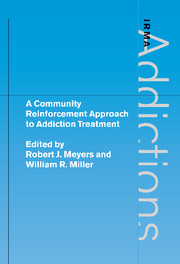Book contents
- Frontmatter
- Contents
- List of contributors
- Preface
- Acknowledgments
- 1 Developing the Community Reinforcement Approach
- 2 Practice and Promise: The Azrin Studies
- 3 The Treatment
- 4 A Comparison of CRA and Traditional Approaches
- 5 Community Reinforcement and Traditional Approaches: Findings of a Controlled Trial
- 6 CRA with the Homeless
- 7 CRA and Treatment of Cocaine and Opioid Dependence
- 8 Community Reinforcement and Family Training (CRAFT)
- 9 Summary and Reflections
- References
- Index
6 - CRA with the Homeless
Published online by Cambridge University Press: 05 August 2012
- Frontmatter
- Contents
- List of contributors
- Preface
- Acknowledgments
- 1 Developing the Community Reinforcement Approach
- 2 Practice and Promise: The Azrin Studies
- 3 The Treatment
- 4 A Comparison of CRA and Traditional Approaches
- 5 Community Reinforcement and Traditional Approaches: Findings of a Controlled Trial
- 6 CRA with the Homeless
- 7 CRA and Treatment of Cocaine and Opioid Dependence
- 8 Community Reinforcement and Family Training (CRAFT)
- 9 Summary and Reflections
- References
- Index
Summary
Homelessness in the United States
Although the homelessness problem in the United States has been apparent for many years, both the magnitude of the problem and its visibility have grown. Furthermore, the individuals who comprise the homeless population have changed dramatically. The “new” homeless are younger, better educated individuals who are commonly from minority ethnic groups. Additionally, today's homeless are more apt to have substance–abuse problems, mental illness, or both (Fischer, 1989; Fischer & Breakey, 1991; Rossi, 1990). Finally, there has also been a substantial increase in the number of homeless women and families, with this subgroup now constituting 25–30% of the total homeless population (Rossi, 1990; Welte & Barnes, 1992).
Given the highly heterogeneous nature of the homeless population and the many needs identified, the task of determining where to focus in order to effectively bring about change has been difficult for clinicians and researchers alike. Nevertheless, one consistent finding has emerged: alcoholism is the most widespread health problem of the homeless (Fischer, 1989; Institute of Medicine, 1988; Lubran, 1989). Probably the two best estimates of alcohol-use disorders within this population are 30–40% (McCarty et al., 1991) or even higher at 45–57% [National Institute on Alcohol Abuse and Alcoholism (NIAAA), 1991]. Furthermore, alcohol-dependent homeless individuals have more extreme problems than the rest of the homeless population in such areas as criminal arrests (Fischer, 1988; Gelberg, Linn & Leake, 1988), poor physical health (Wright & Weber, 1987), victimization (Geissler et al., 1995; NIAAA, 1992a), chronic unemployment (Koegel & Burnam, 1987), illegal drug use, and comorbid mental illness (NIAAA, 1991; Wright, 1989).
Keywords
- Type
- Chapter
- Information
- A Community Reinforcement Approach to Addiction Treatment , pp. 104 - 122Publisher: Cambridge University PressPrint publication year: 2001
- 3
- Cited by



